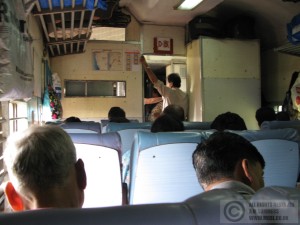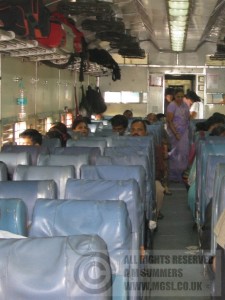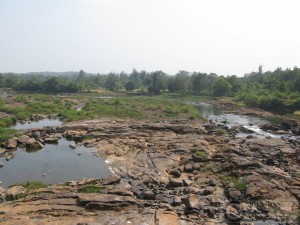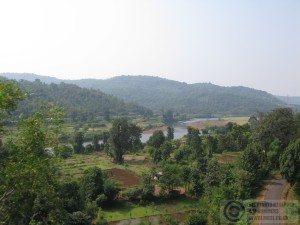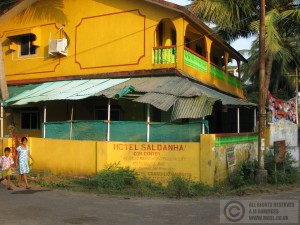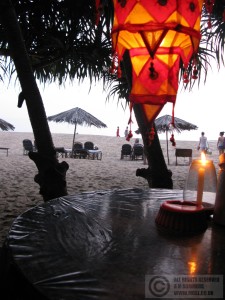Sunday 10th November 2013
Even at 4:30am there are plenty of people on Dadar’s streets, and even more taxis lined up along the station approach. The sign at platform 5 was not showing our train, but there were a few other passengers hanging around. Luckily one of them asked if we were going to Goa and told us that there had just been an announcement to say that it was leaving from platform 7 today. The direct route to platform 7 took us past a somnolent guard who, on seeing foreigners, snapped awake and made us take off our rucksacks to put through an x-ray machine. Those Indians unfortunate enough to be in our vicinity got the same treatment. It was completely pointless – we could quite easily have walked round via unguarded platform 6, bypassing both the guard and the machine.
I was pleasantly surprised that the train was only about a third full as we slid out of Dadar at 05:25 prompt. The seats were arranged aeroplane style, 3 on each side of the aisle, and were reasonably comfortable – especially with the 3rd seat in our row vacant. But I thought it strange, because there had only been 61 seats left when I booked ours, and the train was very long. Then we slowed to pull into Thane station and suddenly the carriage was full of shouting, pushing people, even before we’d come to a complete stop. Indians tend to travel en famille, and that doesn’t mean mum, dad and 1.8 kids. Parties of 10, 12 or more covering 3 or 4 generations are quite normal, together with copious quantities of luggage. A good half hour after we left Thane they were still swapping seats, passing infants around and rearranging luggage (theirs and other people’s) until finally it was all stowed and everybody was happy. Mental note – whenever possible, board a train at its originating point, otherwise there’ll be nowhere to put the bags.
It gets light quickly here. At 6:10 it was still pitch black – by 6:30 the sky had gone through violet and rose pink to a greyish white and it was fully light, although the sun had not yet risen. Barely out of Mumbai the Ghats became visible across the misty plain, a dark blue wall rising into a pale mauve sky. The stretch between Goa and Mumbai was one of the last parts of the Konkan railway to be completed as the hills come right down to the coast, and the train made slow progress. At times we had to stop and wait for an oncoming train pass, and there were frequent long, long tunnels. But after Chiplun the pace picked up and we rattled along at a fair speed. This was a Jan Shatabdi train, a fast train with no sleeping accommodation used on relatively short routes (9 hours is a short route by Indian railway standards). In theory reservations are compulsory so everyone should have had a seat, but there were a good dozen people standing in the lobbies at either end of the carriage, and the family groups didn’t necessarily have a seat for each member of the party. The group of 17 behind us occupied 12 seats – did people just not bother buying tickets for children? Or were some people late in signing up for the trip, couldn’t get tickets, but travelled anyway. Nobody checked our ticket at any point of the journey. The consequence of the seatless passengers was that when the 3rd occupant of our row got off at Ratnagiri, his space was quickly pounced on.
We had obtained a portion of pakora from the hotel restaurant, which we ate for breakfast. We needn’t have bothered – you will never go hungry on an Indian train. We were barely out of Dadar before the first hawker made his way along the train selling passport covers – just what you need at 05:30am. He was quickly followed by sellers of food and drink – samosas wrapped in paper, idlis and vada with a ladle of coconut sauce, cold drinks, chai. No little trolleys for these guys – plastic washing up bowls were the container of choice, or maybe a laundry basket if your cargo was something light and bulky like crisps or biscuits. These were all carried at shoulder height – sod the manual handling implications. The tea/coffee wallah carried an urn of hot water, milk and sugar which was dispensed into a small cardboard cup containing either a miniature teabag or a pinch of instant coffee tipped from a foil-covered cup through a tiny hole. Unbearably sweet and very weak but we had 2 cups each anyway.
Despite the breeze from the ceiling fans and the open windows it did get hot – better that than the A/C chill of first class, but we were glad to get to Margao only 30 mins behind schedule. As we disembarked an official was trying to paste passenger lists onto the carriage, swamped by a crush of people trying to get on. No turnaround cleaning before the next journey then. Luckily neither of us had needed to investigate the toilet facilities…
The taxi arrangements were very well ordered – queue at a booth, pay your money, and give the receipt to the driver of the taxi bearing the correct number. No doubt the system benefits the drivers as well, since it’s effectively a cartel. The fare for Patem was Rs930 – relatively expensive for a 1 hour journey. We found the hotel easily enough (Patnem isn’t big enough to lose a hotel in) but that’s where our so far smooth journey went awry. I’d booked the hotel, the Saldanha, online via a site that required payment up front. Now here we were at the hotel, and there was nobody around. ‘Hotel’ is stretching the description really – it was just a few rooms, 2 or 3 on the ground floor and 3 above, with no evident reception. We could see into one of the ground floor rooms and were not encouraged. We went around the back and called out but the place was deserted, so we hung around for a while, hoping someone would turn up. We tried calling the numbers on the sign outside, but the landline was unobtainable and the mobile was answered by a woman who spoke no English and hung up on me. By now an hour had passed, it was 5pm, we were hot and thirsty, and the hotel on the opposite corner looked reasonable so we did the only sensible thing – booked a room and had a beer. I am not hopeful of getting the money back for the Saldanha, but it’s only £16 so hardly a disaster.
It was dark but still early when we walked down to the beach to find dinner, but we were so tired. Goyam and Goyam, where we stayed on our last visit, is now called April 20 (we were told that the Goyam brothers have gone their separate ways, but the staff are the same, which bodes well for our dining prospects) but doesn’t open until tomorrow. It appears that this is right at the start of the season, as some of the hut camps are still being built or renovated, but we found a place called Mickey’s at the north end of the beach which has been open a whole month. It beckoned us in with colourful lanterns hung above tables nestled among mangrove trees. A very creditable muttar paneer and veg jalfrezi were scooped up with the hottest, freshest naans we’ve ever had, and then we headed for bed, a little TV (James Martin cooking in Naples) and lights out by 9pm, so exhausted were we.


